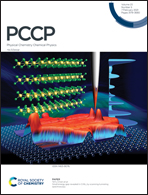Factors affecting the negative Poisson's ratio of black phosphorus and black arsenic: electronic effects†
Abstract
Negative Poisson's ratio (NPR) materials (when stretched longitudinally, the thickness of these materials increases along the lateral direction) are widely used in engineering because of their good resistance to shear, denting, and fracture. Observance of a negative Poisson's ratio (NPR) in two-dimensional (2D) single-layer materials presently has two explanations. The first, from mechanical principles, is that it derives from the presence of a special structure (hinge structure), such as in single-layer black phosphorus (BP) or black arsenic (β-As). The second, from electronic effects, is that it derives from (non-hinge-like) planar honeycomb structures and transition-metal dichalcogenides, MX2. Through first-principle calculations, we show that 2D single-layer materials with a hinge structure also have distinct electronic effects, similar to those observed from 2D planar honeycomb materials. Under strain, electronic effects of Px orbitals lead to the inherent NPR of the 2D single-layer material with a hinge structure. We discuss the influencing factors of the hinge structure on the NPR and demonstrate that the electronic effects inside the hinge structure are the fundamental factor in determining the inherent NPR.



 Please wait while we load your content...
Please wait while we load your content...